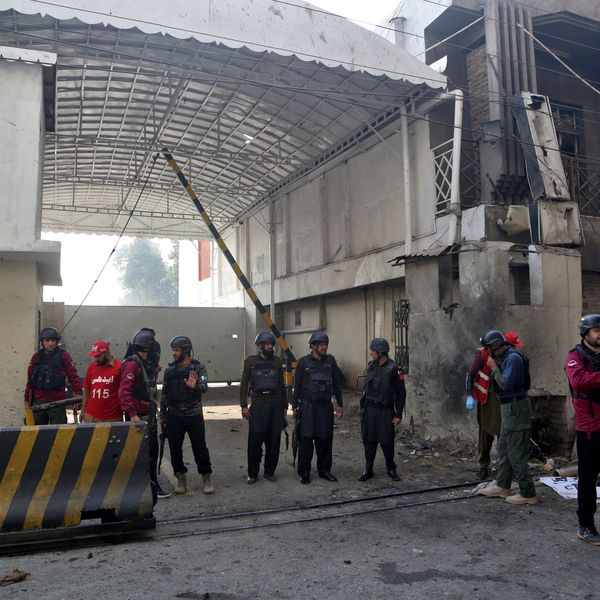How Mossad redefined warfare against Iran
Kamran Khan said Mossad’s success should push Iran to fix its economy, air defenses, and intelligence to protect its 90 million people
News Desk
The News Desk provides timely and factual coverage of national and international events, with an emphasis on accuracy and clarity.
The world may remember the abrupt end of the Iran-Israel conflict as President Trump’s diplomatic intervention. But behind the scenes, an entirely different war was fought -- and won -- long before the first missile was launched.
This was not a conventional war of tanks and soldiers. It was an intelligence war. A shadow war. And at the center of it stood Israel’s covert agency, Mossad, which rewrote the rules of modern warfare with unprecedented precision.
These revelations were shared by Kamran Khan in the latest episode of On My Radar. According to Khan, the 12-day war between Iran and Israel marked not just a geopolitical standoff but also Mossad’s most decisive victory in its decades-long clandestine campaign against Iran. The agency played a pivotal role in targeted assassinations of Iranian nuclear scientists and military leaders -- operations that exposed just how deeply Mossad had infiltrated Tehran’s security architecture.
The Israeli campaign -- code-named Operation Rising Lion -- was far from a conventional military strike. Rather, it was the culmination of years of surveillance, infiltration, and strategic planning by Mossad operatives. The operation exposed the fragility of Iran’s nuclear and defense systems. Backed by precise intelligence, Israel successfully targeted Tehran’s high-security nuclear installations and missile systems, dismantling what Iran considered its most safeguarded assets.
Leading global media -- The New York Times, Wall Street Journal, BBC, CNN, TRT, and Al Jazeera -- have unanimously called this Mossad’s most extensive covert engagement with Iran. Whether Tehran and its allies accept the reality or not, Mossad emerged with a commanding strategic advantage.
Mossad Chief David Barnea said, “This wasn’t months in the making -- it took years. We waited for the right moment to act, ensuring that our response would be both effective and decisive.”
According to Al Jazeera, Mossad’s secret war had already begun long before the first Israeli airstrike. In fact, within hours of the initial attack, Israel began targeting Iran’s surface-to-air missile systems with guided weapons -- moves made possible only through pre-installed, insider intelligence.
What is Mossad and how does it operate in the shadows?
Mossad is Israel’s central intelligence agency -- considered among the most effective spy agencies in the world, alongside the CIA and Pakistan’s ISI. It was established on December 13, 1949, on the directive of Prime Minister David Ben-Gurion. Interestingly, Mossad operates strictly outside of Israel; domestic intelligence falls under the jurisdiction of Shin Bet.
The war began on June 13, 2025, when Mossad activated a secret drone base near Tehran and immediately neutralized Iran’s air defense system. In a stunning twist, one of Israel’s drone-manufacturing plants was located within Iranian territory itself.
According to Times of Israel (June 17, 2025), Mossad leveraged both human operatives and artificial intelligence to map out Iran’s critical air defense, missile, and nuclear facilities.
CNN reported on June 14 that Mossad had essentially turned Iran into its “playground” -- a term justified by Mossad’s 2018 operation to extract Iran’s nuclear archive from a warehouse in Tehran. That archive, which included 55,000 pages and 183 CDs, exposed the full extent of Iran’s nuclear ambitions. Using this intelligence, Prime Minister Netanyahu publicly targeted Iran, leading to President Trump’s decision to withdraw from the nuclear deal in 2018.
Mossad’s success in Iran stemmed from two primary strategies: establishing personal connections with influential figures in Tehran and recruiting thousands of local operatives. According to credible intelligence, hundreds of Mossad sleeper cells were operational across Iran. The Washington Post (June 13, 2025) revealed that these operatives remained dormant for years, only to be activated at a pre-planned moment.
On the war’s first day, Mossad struck Iran’s Natanz nuclear facility, ballistic missile launchers, and top nuclear and military leadership -- operations that had already been 90% prepared on the ground.
CIA Director John Ratcliffe confirmed on June 25 that Iran’s nuclear program had suffered “severe and possibly irreversible damage.” Several top IRGC commanders and nuclear scientists were assassinated inside their homes and bunkers -- many while asleep. In most cases, only the targeted floor or section of a building was destroyed with surgical precision.
The Wall Street Journal reported in detail on Mossad’s operations to smuggle weapon parts into Iran, including electronic fuses, electro-optical cameras, lithium batteries, light engines, GPS systems, and encrypted communication devices. Iranian media itself released evidence linking Mossad to domestic missile and drone production facilities.
Another striking aspect of this campaign was its partial transparency. On June 13, Mossad’s official account posted videos showing weapons transfers and coordinated attacks inside Iran. Al Jazeera reported that this move was designed to exert psychological pressure on Iranian leadership and boost public morale in Israel.
From abducting Nazi war criminal Adolf Eichmann in 1960 to assassinating Iranian nuclear scientist Mohsen Fakhrizadeh in 2020, Mossad has long excelled in covert warfare. Its operations against Hamas, Hezbollah, and now Iran, have only sharpened its capabilities. Middle East expert Holly Dagres told CNN that Mossad’s latest campaign delivered a strategic message to Tehran: “Warfare doesn’t begin with a missile. It begins in the shadows.”
Perhaps the most shocking detail came from The Washington Post, which obtained leaked Mossad audio messages sent just hours before the attack. These were delivered via WhatsApp and Telegram to top Iranian military commanders, including IRGC officers. The messages, in Persian, warned them to surrender, flee, or face complete destruction. In one instance, a message revealed the commander’s name, home address, and even his family’s car registration number—evidence of Mossad’s deep penetration.
What Iran must fix and what Israel must accept
Clearly, this operation was not just about degrading Iran’s military -- it was about striking fear within the IRGC’s core. While Iran has since arrested over 700 suspected local and foreign agents, including reports of some being executed, no military desertions or rebellions have been reported so far.
Yet, as Kamran Khan pointed out, Mossad’s victory should be a wake-up call for Tehran. Iran must now focus on rebuilding its economy, strengthening air defense, and overhauling its intelligence network to protect its 90 million citizens.
It must purge foreign infiltration and revisit its foreign policy, especially its reliance on proxy warfare.
At the same time, Israel must also accept that it is not invincible. Despite Mossad’s intelligence triumph, Iran managed to challenge the myth of Israel’s impenetrable air defenses. The war may have ended, but its message echoes clearly: just as Tehran is vulnerable, so too is Tel Aviv.











Comments
See what people are discussing